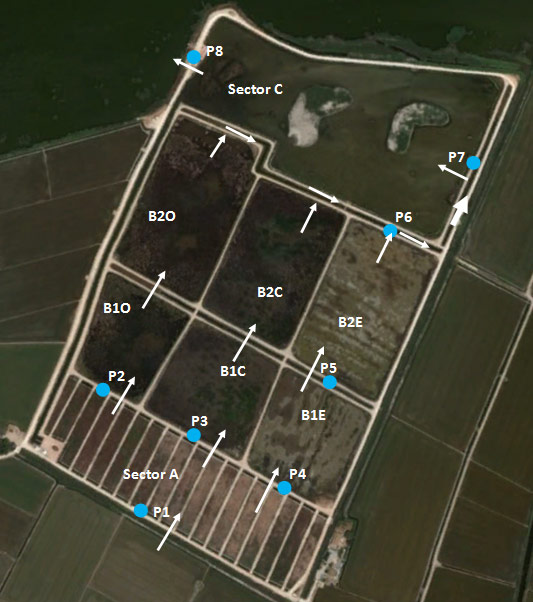One of the tasksof the LIFEAlbufera projectisto takewater samplesboth from the Albufera (in thoseplaces whereconstructed wetlandstake in water) as well as in their effluents. Of each sample different variables aremeasuredthat indicatechanges in the water qualityinsidetheTancats. Inthe respective tabsyou can seethe evolutionof the data obtained intheinput and outputofeach of theTancats. A briefsummary ofthe importance of thesevariables measuring the water qualitycan be found below.
One should bear inmind that we have very little informationon the water quality of the Albufera before the 1980s. This is why it is difficult to establish certain reference values which would be quality indicactors for the variables that are shown here.
Thus, we introduce for guidance typical valuesofthe waters of theJúcaren el azudAntella(source:databaseofthe Hydrographic Confederation of theJúcarcontrasted with our own data), which can be consideredof excellent qualityand,to a greater orlesser extentcanreach the lakebutcannot be consideredas quality objectives to be fulfilled.The values which refer tothe historical situationof the lakeare taken fromthe databaseof the Ministry ofInfrastructure, Planningand Environment (Generalitat Valenciana).
Final Thoughts
Here you can see some partial results of the surveys which are conducted on a regular basis. The data will be updated every two months.
The analysis of the information contained in the accompanying graphs and results of the project will be available at the end of the project.
Acknowledgements
The partners of the LIFE Albufera project would like to thank the Ministry of Infrastructure, Planning and Environment, for its effort in the monitoring network of the water quality of the Albufera of Valencia and the Hydrographic Confederation of the Júcar for maintaining the networks to control the water quality.
Chemical Demand for Oxygen
It is an indicator of the organic matter present in the water which measures the chemically oxidizable organic matter. In this study we have opted for the use of this variable against the Biochemical Oxygen Demand (BOD 5 or BOD20) because in waters with high content of algae, the algae breathing can distort the way to measure organic matter.
Typical values in watercourses of excellent quality in the basin of the Albufera are below 10 mg / l. In aquatic systems as highly eutrophic as the Albufera you can reach values between 50 and 100 mg / l, mainly related to the phytoplankton organic matter; very abundant in these waters.
Suspended Solids
It is an essential variable to assessthe lucency of thewater;key issue inthe development ofsubmerged vegetation.Depending on their characteristicsthey can be themselves an indicator ofcontamination associated withorganic matter oralso indicatethe possible presence ofother contaminants such aspathogenic microorganisms, heavy metals and inorganic phosphorus, among others.
Typical valuesin high qualitywatersin the basinare below10mg/ lwhereas inthe case of the Albufera theyarestrongly associated withthe presence ofmicroalgaewith values thatat timescan exceed100mg/ l.
Total phosphorus and total nitrogen
Both phosphorus and nitrogen are essential nutrients which contribute to the eutrophication process. In our case, and usually in inland waters, phosphorus is the limiting nutrient to which we should pay more attention.
Total phosphorus values greater than 0.100 mg P / L indicate high probability that this lake is in a hypertrophic state. In the case of the Albufera, the values are placed around 0.250 mg P / L, which is consistent with the fact that their state is hypertrophic. Normal in the basin is below 0.070 mg P / L.
The environmental importance of total nitrogen depends on the form in which it is located. Very high concentrations of oxidized nitrogen (more ammoniac organic matter) increase the consumption of dissolved oxygen which can, together with other consumptions, lead to problems of anoxia (lack of oxygen in the water). Basin waters with excellent quality are below 1.5 mg N / L, its main components are nitrates. For the Albufera, the values are about 5 mg N / L.
Conductivityand dissolved oxygen
Measuring theelectrical conductivityprovides information onthe concentrationof dissolved salts. Evaporationwhich occursin constructedwetlandsincreases theconcentration of salts, so that one should pay attention to the management ofthese spaces to avoid that this increaseis not excessive.The conductivity(at 25 degrees) of the good quality basin wateris about1000mS/ cm.The conductivityin the lakedepends onthe season(weather) andwater resourcesarriving: in dry yearsthe average annualvalue is between1900and 2000mS/cm,while inwet yearsthe values rangebetween 1500and 1700mS/ cm.In 1995, the driest ofthe last 20 years, the average annual valuereached almost3500mS/ cm.
The concentration ofdissolved oxygenis anotherkey indicator of the water qualityof an aquatic ecosystem. The closerto its maximum value(saturation concentration) the better the quality of thosewaters:valueswell belowthemaximumindicatethe presence ofsubstances(biodegradable organic matter, oxidizednitrogen,breathingalgae and /or plants) which consumeoxygenwhile valueswell abovethisindicatehigheutrophication(photosynthetic production). Therefore, inthe following graphicthe value is shown, not ofthe concentration ofoxygen,butthepercentagewith respectto saturationat the timeofsampling(between 10:00 and11:00 in the morning).
Chlorophyll a
Chlorophyll a is a photosynthetic pigment in natural waters which indicates the presence of phytoplankton. In the bibliography exist values which differ from the trophic state of an aquatic ecosystem, but they should be applied as guidance since for a correct classification other indicators need to be used.
For example, one of the most used classification methods (OECD, 1980) establishes the value of passing from a eutrophic system to a hypertrophic system in 25 mg CL a / L (average annual value) and 75 mg Cl / L (annual maximum). In the 80s, the Cl concentrations in the Albufera reached values next to 800 mg Cl / L, the maximum value was reached in 2013 with 215 mg Cl / L and an annual average of 105 mg Cl / L.
TANCAT DE MILIA

TANCAT DE L’ILLA

TANCAT DE LA PIPA

